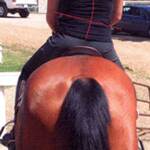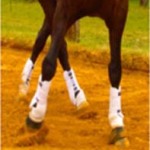Alignment & Posture (Horse)
One of the things I talk about at my clinics is how important awareness of our body’s posture is for both us and our horses. Whilst most people accept ...
Asymmetry in the Horse
We all know that horses and humans are naturally asymmetrical - and our lifestyles and injuries exacerbate that asymmetry. Obviously we can ignore our ...
Balance & the Aids
Does your horse fall in on a left circle and fall out on a circle to the right, or vice versa? Does he toss his head or try breaking into a canter when ...
Bending
The ability of a horse to bend depends on his suppleness and flexibility. Although we often think about a horse bending from poll to tail, this actually ...
Contact & Rein Pressure
Contact is the third building block in the classic German Scales of Training pyramid following after Rhythm and Suppleness (sometimes shown as Relaxation). ...
Correcting Crookedness
I originally wrote this post in 2018 but it is as relevant now as it was then. As anyone who has followed my articles for any length of time or ...
Groundwork 1
As I have mentioned so frequently, neither humans nor horses are symmetrical. We are born left or right handed (hoofed) and become progressively more ...
Groundwork 2
In the previous article Groundwork 1 we looked at how to achieve forward down and stelling and bending at a halt. In this article I would ...
Groundwork 2 – the beginning of refinement
Last month I wrote an article about Starting Groundwork to improve your communication with your horse and help to gymnastise his body by using basic leading ...
On the Bit
So many riders and trainers talk about having the horse “On the Bit” but what do they really mean by this ambiguous statement? Do they mean pull on ...
Pilates Exercises for Your Horse
By now we have all heard that Pilates is really good for us. When done regularly the benefits of Pilates are numerous, including strengthening our core ...
Relationship
It has been a couple of months since I last wrote my last article, as apart from being on holiday and spending spent some quality time with my own horses, ...
The Importance of Footfall
Being able to feel the footfall of your horse and knowing at any given time where each of your horses legs are, is or should be, the foundation of good ...
The Importance of Lateral Movements
Many riders avoid doing any lateral movements with their horse. This can be because of fear of doing them wrong and "hurting" their horse, lack of knowledge ...
The Importance of Straightness
All horses and all humans are asymmetrical to a greater or lesser extent. The muscles on one side of the body are stronger than the other, one side may ...
The Importance of the Core
Whether we are talking about humans or horses a strong and supple core is required to support the spine and reduce wear and tear on the joints. For riders ...
The Importance of the Feet
So far in this series we have looked at "the importance of straightness" and "the importance of the hips". But just as you can’t build a house without ...
The Stifle
The stifle is the largest, most complex joint in the horse, and probably one of the weakest. The bones that make up the stifle are the femur (thigh), ...
Troubleshooting – or listening to your horse
One of the biggest concerns many students seem to have after attending a lesson or a clinic, is how they can continue schooling by themselves. Of course, ...
Turn on the Forehand in Motion
The turn on the forehand in motion is one of the first lateral movements that you can teach your horse. The movement is not found in any dressage test, ...
Turn on the Haunches
When done properly the “Turn on the Haunches” or “Pirouette” is one of the most effective gymnastic exercises for your horse that you can do. ...




















